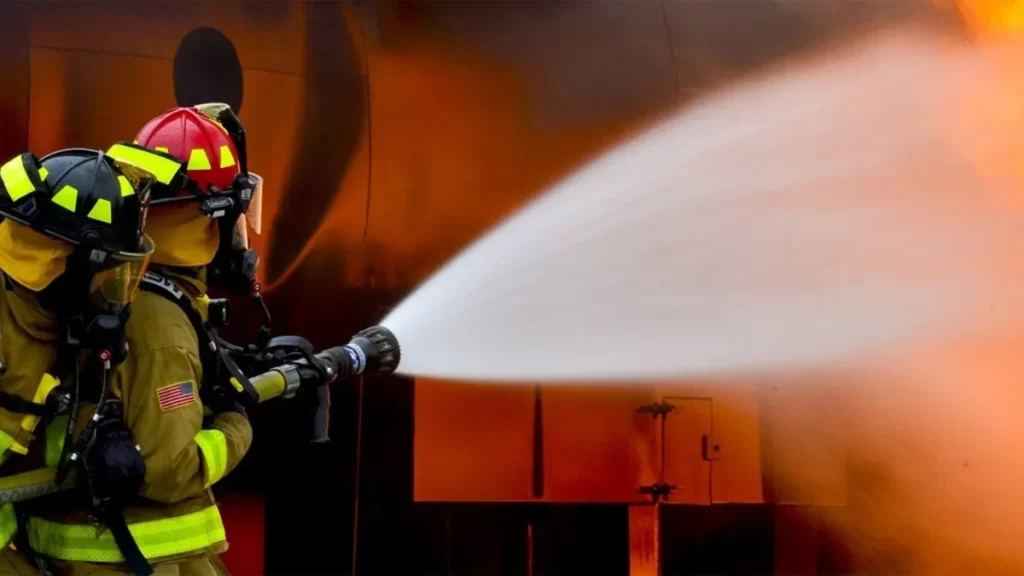Fire Alarm System – Function, Element, Types & Installation


Fire Alarm System Installation In India
Fire Alarm System Installation
A fire alarm system has different electronic devices that perform together to detect and inform people of a fire or other emergency. Over the years, fire alarm systems have evolved increasingly sophisticated, so we guide you to help you understand all the components of a fire detection alarm system and get the most out of this critical technology.
A Quick History of Fire Alarm Systems
Alarm systems have developed extensively since Francis Robbins Upton, a Thomas Edison associate, patented the first automatic alarm system in 1890. Twelve years later, in England, George Andrew Darby invented the first heat and smoke detection systems, and in 1965, battery-powered smoke alarms first occurred. Since the 1980s, building codes have needed the installation and usefulness of battery-powered smoke alarms.
Get Fire Alarm System Installation, Inspection, Testing & Maintenance
How Do Fire Alarm Systems function?
A Fire Alarm System Installation purpose is to notice fires and fast notify both the occupants of the building and emergency services from a centrally managed and observed location. These systems also observe themselves, recognizing the location and source of the alarms and sensing issues with connections and wiring that might stop the system from working. Fire detection systems have primary functions which are: –
- Detection
- Alertness
- Monitoring
- Controlling
These highly advanced systems utilize a network of devices, appliances, and control panels to complete these four functions. To support you better understand the workings of an alarm system, we’ll concern each component in detail below.

Elements of an Alarm System
A fire alarm system consists of multiple elements, including:
- Fire alarm control panel
- Initiation devices
- Pull stations
- Smoke detectors
- Duct detectors
- Heat detectors
- Beam detectors
- Air aspirating
- Water flow switches
- Tamper switches
- Notification devices
- Audible devices
- Strobes
- Strobes/Horns
- Dialers or communicators
- NAC power supplies
Here we’re going to describe what each element does.
Fire Alarm Control Panel
The fire alarm control panel abbreviated as FACU is the system’s “brain.” It acquires messages from the initiating instruments, also known as inputs, and performs the following procedures.
- Turning on warnings: Upon obtaining signals from the inputs, the FACU will turn on the required notification devices, also known as outputs. It warns individuals in the area that an issue has arisen.
- Elevator recall: The FACU also recalls elevators, removing the danger of an elevator transporting passengers to a location covered with flames or smoke.
- HVAC system shutdown: Many fire alarm systems will turn off the air handling unit if they notice smoke in an air duct, stopping smoke from spreading to other areas of the structure.
- Informing alarm monitoring center: A remote alarm monitoring station will also be informed by the FACU, and it will contact emergency services.
Types of Fire Alarm Panels
The types of fire alarm systems include: –
- Addressable: Addressable panels keep an eye on each alarm element. Each device has its unique address, allowing the control panel to determine whether it is in operation, alarm, or in trouble. For instance, addressable systems make it possible for front desk staff in hotels to determine the precise location of an occurrence by viewing the alarm panel display.
- Non-addressable: This type of alarm system puts all initiating appliances in zones, suggesting users physically have to review each device in that zone to see the one in alarm. For instance, if you have a non-addressable system and the alarm runs off, it would inform you something like “Alarm Zone 3, Fourth Floor.”
Most belongings owners and supervisors choose addressable systems, as they let you know the exact location of the alarm and evaluate the situation much more quickly. Some fire alarm panels can also inform remote alarm monitoring stations, which can contact emergency services. Most state laws do not permit direct contact with fire departments.
Three States of a Fire Alarm System
Fire alarm panels often monitor and display the state of the fire alarm system. For the majority, there are three possible states.
- Normal: “Normal” includes all appliances, devices, circuitry, and wiring functioning accurately and that there are no active alarms.
- Alarm: It means an active alarm.
- Trouble: If available or short wiring develops in the circuits that attach the initiating devices and the fire alarm panel, or if the system’s phone line connection isn’t functioning, the system will go into a “trouble” state, which the control panel will indicate.
Initiation Devices
Similar to alarm panels, initiation devices can be addressable or non-addressable and set off alarms. Some initiation devices, such as water flow switches, connect to addressable modules despite being conventionally non-addressable. To connect with addressable systems, the switches might have unique addresses.
Initiation devices come in a variety of varieties. Initiation devices can be, in addition to water flow switches:
- Pull stations
- Duct detectors
- Smoke detectors
- Beam detectors
- Heat detectors
- Tamper switches
- Air aspirating detectors
Pull Stations
The part of a fire alarm system that you probably know the most about is a pull station. It is a manually operated gadget that sends out an alert when its handle is pulled. When there is a fire or other emergency, you can activate a pull station in just a few seconds, whereas smoke may take a few minutes to reach a smoke detector. This enables a quicker evacuation and quicker response times from the fire department. Pull stations can be ordered with protective covers and come in various sizes and shapes.
Smoke Detectors
When it detects smoke, a smoke detector sends out an alarm signal. Depending on the kind of sensor they use to identify smoke particles, these devices fall into one of two categories.
- Ionization detectors: These detectors have tiny amounts of radioactive material sandwiched between two plates that are electrically charged. Smoke atoms obstruct the movement of ions between these two charged surfaces. When this occurs, the smoke detector sounds.
- Photoelectric detectors: Photoelectric detectors radiate LED light beams in their detecting chamber. When smoke particles enter this chamber, they spread the beam of light, deflecting part of it on the detector’s photoelectric sensor, and some of it is refracted onto the photoelectric sensor of the detector. The alert sounds when the sensor notices this light.
Duct Detectors
Duct detectors are smoke detectors established in air conditioning and heating ducts. They closed air handling units down, controlling smoke from traveling all over the structure via the air ducts.
Heat Detectors
Heat detectors are fire detection devices fitted with sensors that react to heat. Two main types of heat detectors are: –
- Rate-of-rise heat detectors: This type of heat detector will react if the temperature boosts at a rate that exceeds a specified value.
- Fixed temperature heat detectors: Fixed temperature heat detectors react when their operating elements reach or exceed a predetermined temperature. There are two types of fixed-temperature heat detectors: linear detectors, which monitor the temperature throughout a location, and spot detectors, which observe the temperature in one specific location.
Beam Detectors
This smoke detector casts a light beam over the space it guards. The detector will activate if smoke enters the beam’s path. This kind of smoke detector emits a beam of light that covers the entire space. The detector will turn on if smoke gets in the way of the beam.
How Do Fire Alarm Systems Integrate with Life Safety Technology?
Sometimes, building codes require integration between fire alarm systems and other technology. But, in other cases, integration is optional and voluntary, such as with lighting systems, door locks, security systems, and HVAC systems. While these systems need independent network communications, they can work on a conveyed infrastructure, keeping your money and streamlining processes.
Some examples of functions and systems interfaced with fire alarm systems are:
- Extinguishing systems like automatic sprinkler systems
- Ability interruption and elevator recall
- Smoke control
- HVAC fan and damper controls
- Door unlocking and release
- Safety systems
- Mass information systems
- Monitoring of fire extinguishers
According to the National Fire Alarm and Signaling Code, the above is “fire safety functions” to improve occupants’ life safety or prevent the spread of fire. You can choose to integrate other systems for various reasons, for their operational advantages, information sharing, and cost protection.
How Often Do You Require to Inspect Fire Alarms?
You can understand the requirements for inspecting, testing, and maintaining fire alarm systems, their notification appliances, and initiating devices, in Chapter 14 of NFPA 72 ‘National Fire Alarm and Signaling Code. But, we will recap these needs below.
Visual Inspections
You should have the features of your fire alarm visually inspected every week, month, six months, or annually, according to NFPA 72’s schedule in table 14.3.1. But, these schedules can vary depending on your local laws. Standard visual inspections have the following.
- Control equipment: Check every week to confirm the system is working perfectly. That contains inspecting the LEDs, power supply, and fuses and noticing if there are any trouble signals.
- Batteries: Depending on the batteries, you must check once or twice a month for leakage and corrosion.
- Heat detectors, duct detectors, and smoke detectors: Review these semiannually.
You must check all equipment yearly to confirm any changes affecting its performance.
Testing
Testing components involves more phases than visual inspections, but it’s unnecessary to do it as constantly. Though several components require semiannual testing, most components only need once-a-year tests, according to NFPA 72’s table 14.4.3.2. Like with inspections, your testing schedule can vary depending on local laws and authority-having jurisdiction.
- You must test this once a year to ensure proper receipt of the alarm, supervisory and hazard signals.
- You must inspect and verify both visual and audible trouble signals yearly.
- Test this by unplugging all your primary power supplies.
- You must visually and audibly verify that these are working perfectly.
Maintenance
You must maintain the elements of your fire alarm system according to the instructions published by your manufacturer. How often you perform maintenance relies on environmental conditions and the kind of equipment you have.
https://youtu.be/cveuVXqrYq4https://youtu.be/vouWAx-VWhghttps://youtu.be/aMi7iXD0l9I



